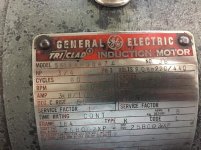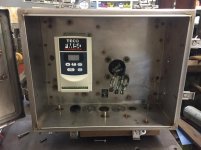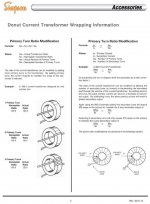Grigg
Hot Rolled
- Joined
- Jun 25, 2007
- Location
- Lexington, VA
Hello,
I'm trying to figure out what current transformer to shop for given the following use:
Adding a 3/4 HP 3 phase motor as alternate power source for a diesel powered ice cream machine, remove one belt install another, plug it in and churn.
The electric motor is 3.6 amps at 220V.
Using VFD as phase converter and voltage booster so this can plug into a normal 115V outlet.
TECO FM50-101-C AC Drive, 1 HP, 115V 1 PH Input, 230V 3 PH Output, 4.2FLA,
Input is about 16 amps max at 115V single phase.
The meter is an old one and shows fractions of full load. Load will increase as the ice cream sets up; so with some experience I'll know from the meter when a batch is almost done. Not necessary that the scale be calibrated so long as the needle movements are useful as above.
On the face of the meter "C.T. RATIO 100:5 and FS=5A" which I take as current transformer ratio and full scale amps.
I think it'd be best to measure/indicate current from the 115V input to the VFD and not the 3 phase output, I'm guessing 5-10 amps might be usual range and not more than 15-16 amps.
How do I calculate and decide which current transformer to shop for?
And/or will most any 100:5 current transformer work if I loop the load wire through as many times as needed to get a useful reading on the meter?
Pictures of components below. The VFD, input circuit breaker, meter, and current transformer will all be in a stainless box mounted on the motor.
I have already tested the motor on 3 phase with a double batch and it performed well, didn't lug down noticeably or heat, unfortunately I wasn't able to measure amp draw.
Thanks,
Grigg
![IMG_2602[1].jpg IMG_2602[1].jpg](https://www.practicalmachinist.com/forum/data/attachments/193/193385-45da37235d98fcc299d6224055784e4a.jpg)




I'm trying to figure out what current transformer to shop for given the following use:
Adding a 3/4 HP 3 phase motor as alternate power source for a diesel powered ice cream machine, remove one belt install another, plug it in and churn.
The electric motor is 3.6 amps at 220V.
Using VFD as phase converter and voltage booster so this can plug into a normal 115V outlet.
TECO FM50-101-C AC Drive, 1 HP, 115V 1 PH Input, 230V 3 PH Output, 4.2FLA,
Input is about 16 amps max at 115V single phase.
The meter is an old one and shows fractions of full load. Load will increase as the ice cream sets up; so with some experience I'll know from the meter when a batch is almost done. Not necessary that the scale be calibrated so long as the needle movements are useful as above.
On the face of the meter "C.T. RATIO 100:5 and FS=5A" which I take as current transformer ratio and full scale amps.
I think it'd be best to measure/indicate current from the 115V input to the VFD and not the 3 phase output, I'm guessing 5-10 amps might be usual range and not more than 15-16 amps.
How do I calculate and decide which current transformer to shop for?
And/or will most any 100:5 current transformer work if I loop the load wire through as many times as needed to get a useful reading on the meter?
Pictures of components below. The VFD, input circuit breaker, meter, and current transformer will all be in a stainless box mounted on the motor.
I have already tested the motor on 3 phase with a double batch and it performed well, didn't lug down noticeably or heat, unfortunately I wasn't able to measure amp draw.
Thanks,
Grigg
![IMG_2602[1].jpg IMG_2602[1].jpg](https://www.practicalmachinist.com/forum/data/attachments/193/193385-45da37235d98fcc299d6224055784e4a.jpg)









